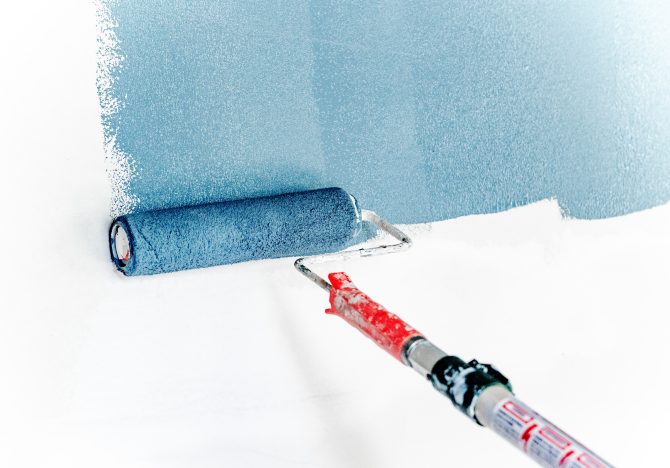Two Natural ‘miracle’ Paints
Advice

Although EU legislation restricts the VOC (volatile organic compound) content of paints, it does not prohibit their use. VOCs are harmful to health and the environment. A number of well-known brands have altered or discontinued their solvent-based paints, but many water-born paints still contain harmful levels of VOCs.
Although low VOC content is important, most paints that are labelled ‘eco’ ‘green’ are in fact water-based acrylic ‘latex’ paint. These are fast-drying paints containing pigments suspended in an acrylic polymer emulsion, often with other ‘nasties’ such as acrylic softeners, ammonia or formaldehydes. The VOC emissions of such paints may be low, but acrylic polymers are derived from petroleum products. When using these paints, you are in fact smearing a form of plastic on your walls or woodwork!
Long before the EU regulation of VOC content, a few companies have been producing paints with only natural, non-toxic and often organic ingredients. In the UK, Ecos Paints and Earthborn are good examples. Natural paints are paints made from ingredients such as water, plant oils and resins, plant dyes, essential oils, clay, lime, talcum, milk casein, natural latex, bees wax, earth and mineral dyes. Allergies and sensitivities to these paints are uncommon and they are the safest for your health and for the environment.
Two of my favourite types of natural paints available in France are linseed-oil paint for woodwork and metal, and clay paint for walls. Not only do these paints not contain toxins, but they perform better than modern paints, have a more authentic appearance when restoring French period properties and tend to be less expensive due to their higher performance.
Linseed-oil paint for interior and exterior woodwork & metal
Linseed-oil paint, which was first used in the 1700s and almost disappeared after WW2, is enjoying a revival. This is not surprising when looking at its many benefits:
– Linseed oil is a ‘drying oil’, which means that the initial material is liquid but after a period of exposure to air it hardens to a tough, solid film. The result is an aged material that is stable and rigid but remains somewhat elastic, which is why linseed-oil paint does not crack.
– Linseed oil molecules are small and therefore penetrate deeply into wood pores, nourishing the wood without expanding it. The molecules also repel water.
– The paint allows the wood to breathe and does not trap water underneath it.
– External wood painted with three coats of high quality linseed-oil paint will only require a coat of boiled linseed oil after six to eight years (no sanding needed) and after approximately 15 years an additional single coat of linseed-oil paint. By contrast, modern exterior paint (whether water based or oil-based) sits on the surface of wood. As it does not penetrate or stick to wood, water enters small cracks in the paint and when moisture becomes trapped, peeling paint and decaying timber are the result. This is why even a so-called high quality modern exterior paint starts flaking so soon and needs to be sanded down and repainted after four to six years, if not sooner.
– Linseed-oil paint made with pure oil derived from flax grown in the correct conditions does not need to be diluted with any chemicals or solvents and VOC levels are less than 18g/l, more than 16 times less than the legal limit. This means that it has 100% dry weight and nothing will evaporate. In a typical pot of acrylic or alkyd (oil) paint, approximately 50% is solvent, which all evaporates as the paint dries. So about half the paint you purchased goes into the atmosphere. Linseed-oil paint therefore has a much higher paint coverage ratio than modern paint, making it more cost-effective.
– The use of natural pigments and the semi-gloss aspect of linseed-oil paint results in colours that are particularly suitable for older properties. Recently, linseed-oil paint has been used at Versailles.
In summary: linseed-oil paint is not just toxin free and environmentally friendly but nourishes the wood, lasts longer, is easy to repaint, looks better and is more cost-effective.
Architect Kevin Davies at Peinture Authentique, the French distributor of Swedish Allback Linseed Oil Paint used at Versailles warns me to keep two important things in mind when looking for linseed oil paint:
“Firstly, the quality of linseed-oil paint is affected by the composition of the oil and its processing. In order for linseed oil to be suitable for use in paint, it needs to have been grown in a cold and damp climate. Linseed grown too far south does not have a high enough linolenic acid content. The raw linseed oil should also be cold pressed and cleaned of all impurities and proteins, as the latter two provide food for fungal growth and cause paint to yellow after time, which was a common trait of earlier linseed-oil paints. This means that when you buy linseed-oil paint you need to check with the manufacturer to make sure that the linseed oil used was grown in the north and has been properly purified. If the oil was not purified, you’ll usually find solvents such as turpentine added to the paint.”
“Secondly,” he continues, “the protective and nourishing qualities of linseed oil paint can only fully be enjoyed if applied to bare wood, which means that existing paint (other than linseed-oil paint) first needs to be removed. You could simply paint over it, but the paint underneath will still fail in the normal time period, so you would not get the benefits of a longer life cycle or protection of your wood.”
Linseed-oil paints can be obtained from only a handful of companies worldwide.
Clay paint for interior walls and ceilings
This exciting and natural alternative to emulsion paint is made from clay- and earth-based minerals. Each manufacturer has its own recipe and some clay paints are smoother and thicker than others.
Clay paint shares many of the benefits of lime wash, such as:
– humidity regulating due to high moisture absorbability;
– ultra matt finish which enhances and softens the light in a room and hides hairline cracks;
– entirely natural and odour free (you can paint next to a sleeping baby!);
– anti-bacterial and anti-fungal properties make it ideal for people with allergies or asthma (clay emits negative ions).
In addition, clay paint has benefits that lime wash does not, which is why clay paint now is my favourite wall finish.
– Applying lime wash can be a bit messy and cumbersome as it is such a runny liquid. Clay paint is thicker, has better coverage, and is much easier to apply making it even suitable for ceilings and beams.
– When applying clay paint, you can stop in the middle of a wall and start a day later without seeing any colour difference. Touch ups are also no problem. Lime wash has to be applied in one go (per wall) and touch ups are always visible.
– Clay paint can be applied with a brush, a roller or a spray gun and does not have to be re-mixed constantly.
– Atmospheric conditions do not affect the final result of clay paint finishes. Lime wash, on the other hand, requires a slow drying process in order for carbonization of the lime to happen. If it dries too quickly, the result will be a cracked or flaky surface.
– Lime wash works best on porous surfaces, but most clay paints can be applied to any surface, even interior timber. It can also be applied over still humid plaster and over lime wash.
Clay paint is wipeable but due to its breathable nature, will absorb liquid stains. This has not stopped us from using it in our gîtes and as it can so easily be touched up I simply paint over any stains. There is no odour, so I can even do this on changeover days. Its vapour permeability makes it perfect for use in bathrooms, provided that splash backs are tiled. I also recommend clay paint to owners of second homes in France that are damp prone and left unoccupied for periods of time. No more mildew and musty smells when arriving after a long absence!
In the UK, claypaint is available from many suppliers. In France, most ecological building supplies stores stock clay paint. Olterre produces Nat’Argile and Batimieu sells Conlino, both ready-to-mix powdered clay paints that come out a bit cheaper than the ready mixed paints, but perform less well than the two English paints mentioned. With any clay paint, you can of course also add natural pigments and ochres to white paint to create your own colour. Do note down the proportions for next time, though!
Share to: Facebook Twitter LinkedIn Email
More in courses, cycling, food, health, legal, people, renovation
By Sophia Mose
Leave a reply
Your email address will not be published. Required fields are marked *



